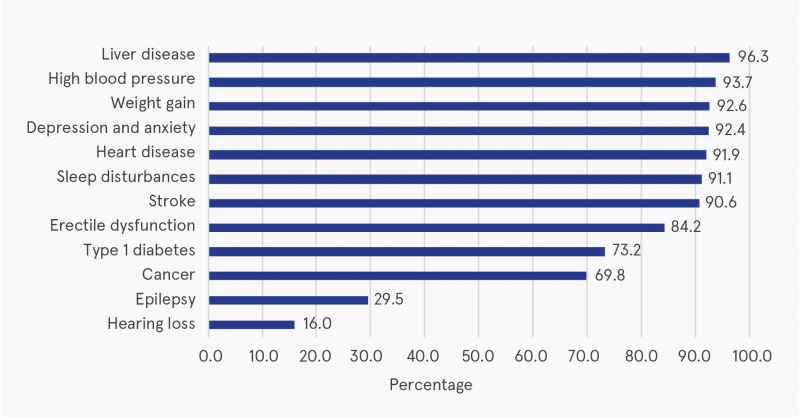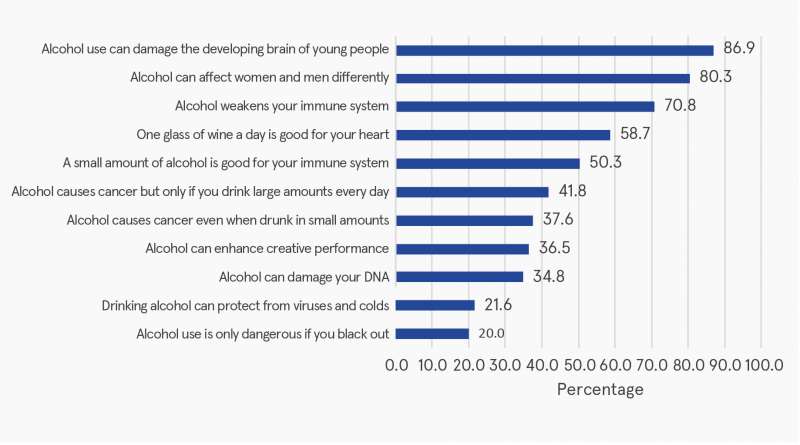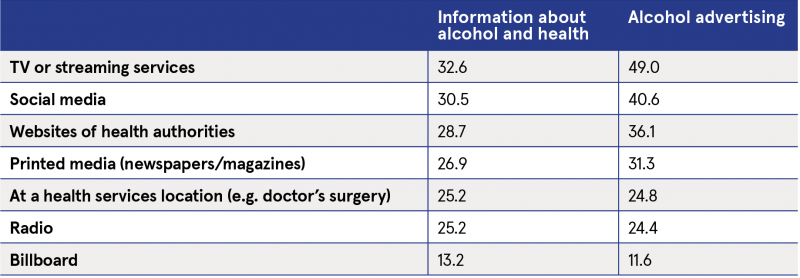Doyle, Anne  ORCID: https://orcid.org/0000-0002-2776-3476
(2025)
Understanding knowledge and attitudes towards alcohol consumption – findings from the Evidence into Action Alcohol Project (EVID-ACTION).
Drugnet Ireland,
Issue 90, Winter 2025,
pp. 19-22.
ORCID: https://orcid.org/0000-0002-2776-3476
(2025)
Understanding knowledge and attitudes towards alcohol consumption – findings from the Evidence into Action Alcohol Project (EVID-ACTION).
Drugnet Ireland,
Issue 90, Winter 2025,
pp. 19-22.
| Preview | Title | Contact |
|---|---|---|
|
PDF (Drugnet Ireland issue 90)
1MB |
Introduction
Alcohol use is highest in the World Health Organization (WHO) European region.1 Cancer is the leading cause of death due to alcohol use in Europe, and yet, awareness of this link between alcohol use and seven different cancers is low, particularly for breast cancer.2,3 Collaborating with the European Union (EU), the WHO aims to reduce alcohol use and related harms and increase awareness of the risks through a project called the WHO-EU Evidence into Action Alcohol Project (EVID-ACTION), co-funded by the EU as part of Europe’s Beating Cancer Plan.4,5 The project covers 30 countries, including Ireland, and the focus is on building evidence for the case for alcohol health warning labels, supporting and sharing experiences and expertise among members, and providing tools and training to support implementation of screening and brief interventions in a variety of contexts. In order to gain a better understanding of the current level of knowledge and attitudes towards alcohol use, a survey was completed in five European countries, including Ireland. The findings from the Irish sample are presented here.
Methodology
An online survey was conducted among a sample of 620 participants (49.6% female) aged between 18 and 84 years. The survey included questions about alcohol use; opinions on Irish policies on alcohol, and social and cultural norms; knowledge of health consequences of alcohol use; exposure to health information about alcohol use and exposure to alcohol advertising; and opinions about alcohol initiation.
Results
Drinking patterns
Just 7.3% of the sample reported that they were non-drinkers and more than one-half reported drinking at least weekly (50.3%), 22.1% reported drinking at least five standard drinks on a typical drinking occasion, and 37.5% indicated that they drink enough to feel drunk at least once per week. Most respondents consider themselves to be an occasional drinker (32.9%) or a social drinker (24.3%) and just 2.1% consider themselves to be a binge drinker.
Opinions on alcohol use
When asked how ‘worth it’ they consider drinking alcohol is, 9.7% claimed drinking alcohol is ‘worth it’ and 11.8% claimed it is ‘not worth it’. All other responses were fairly evenly divided along a 6-point scale between ‘worth it’ and ‘not worth it’.
Most respondents felt that it was ‘acceptable’ to start drinking at 18 years and over (81.7%) and to get drunk for the first time at 18 years and over (90.5%).
Almost one-half of respondents strongly agreed that regularly consuming alcohol at social gatherings is common among the population of Ireland (44.5%), 27.1% strongly agreed that regularly drinking alcohol at home is common, and 25.8% strongly agreed that most people are comfortable drinking while children are present.
Risk factors associated with alcohol use
The majority of respondents recognised that alcohol use can cause liver disease (96.3%) and 69.8% were aware of the risk of cancer due to alcohol use (Figure 1).

Figure 1: Percentage of respondents indicating that alcohol can cause the listed health conditions
Respondents were also asked what, if any, cancer types did they think can result from alcohol use. Two-thirds of respondents recognised that liver cancer is associated with alcohol use (66.5%). Awareness of other cancers that are associated with alcohol use was lower. For example, 30.0% said throat cancer can result from drinking alcohol, 29.2% said mouth cancer can result from drinking alcohol, and just 17.3% recognised the link between alcohol use and breast cancer.
Knowledge of other risk factors associated with alcohol use was mixed. The majority of respondents recognised that alcohol use is damaging to the developing brain (86.9%). Fewer respondents were aware that alcohol can cause cancer even when consumed in small amounts (37.6%) (Figure 2).
Almost one-half of respondents strongly agreed that alcohol harms not only the drinker but others too (46.5%), and 46.0% felt strongly that young people should be taught by parents how to ‘drink in moderation’.

Figure 2: Percentage of respondents who indicated that the statements listed were true
Sources of information about alcohol and exposure to alcohol advertising
Alcohol advertising was noticed more by respondents than was information about alcohol and health (Table 1).
Table 1: Sources where respondents encountered information about alcohol and health, and alcohol advertising in the last 12 months (%)

Two-fifths of respondents indicated that they find healthcare providers a very trustworthy source of information about the relationship between alcohol use and health, whereas just 9.8% said the same about non-profit organisations funded by the alcohol industry.
Opinion on alcohol policy
Over one in ten respondents strongly agreed that the price of alcohol should be increased (10.9%). Support was greater for health warning labelling and limiting alcohol advertising (29.9% and 27.5%, respectively, strongly agreed).
There was strong agreement for implementing strict drink-drive measures (55.4%), increasing treatment for alcohol use disorders (46.8%), providing funding for school educational programmes (42.9%), and providing funding for communication campaigns on alcohol and health (35.3%).
Conclusion
The findings from this survey confirm that the majority of people in Ireland drink alcohol, and drink regularly. Although awareness of the link between alcohol use and liver disease and liver cancer was high, there was poor awareness of the link between alcohol use and breast cancer (17.3%). The findings are similar to those of an Irish study based on a representative sample of the population, which found that 21% were aware of this link.3
The survey indicated that exposure to alcohol advertising is high among the sample, particularly on TV, streaming services and on social media. The commencement of Section 19 of the Public Health (Alcohol) Act 2018, (broadcast watershed), in January 2025 will limit some of this exposure to alcohol advertising on TV at least.
Support for alcohol policies is high among respondents, with strong support for health warning labelling on alcohol products, which is due to commence in May 2026.
1 World Health Organization (2024) Global status report on alcohol and health and treatment of substance use disorders. Geneva: World Health Organization. Available from: https://www.drugsandalcohol.ie/41287/
2 O’Dwyer C and Mongan D (2019) Public awareness of alcohol-related health conditions in Ireland: findings from the Healthy Ireland Survey. Drugnet Ireland, 70 (Summer): 19–21. Available from: https://www.drugsandalcohol.ie/31013/
3 Doyle A, O’Dwyer C, Mongan D, et al. (2022) Factors associated with public awareness of the relationship between alcohol use and breast cancer risk. BMC Public Health, 23: 577. Available from: https://www.drugsandalcohol.ie/37780/
4 European Parliament and the Council (nd) Europe’s Beating Cancer Plan. Available from:
https://health.ec.europa.eu/document/download/26fc415a-1f28-4f5b-9bfa-54ea8bc32a3a_en (accessed 13 Sep 2024).
5 World Health Organization (2023) Launch of the WHO – European Union Evidence into Action Alcohol Project: Meeting report, Copenhagen, Denmark, 6 December 2022. Geneva: World Health Organization. Available from:
https://www.who.int/europe/publications/i/item/WHO-EURO-2023-8230-48002-71090
B Substances > Alcohol
F Concepts in psychology > State of consciousness (sleep)
F Concepts in psychology > Attitude > Attitude toward substance use
G Health and disease > State of health
G Health and disease > Pathology > Cancer
G Health and disease > Cardiovascular / heart disease
G Health and disease > Digestive / endocrine system disease
G Health and disease > Digestive / endocrine system disease > Liver disease
G Health and disease > Neurological condition / disease (nervous system, brain) > Epilepsy
MA-ML Social science, culture and community > Sociocultural aspects of substance use > Societal attitude toward substance use / public opinion
MP-MR Policy, planning, economics, work and social services > Marketing and public relations (advertising)
N Communication, information and education > Information use and impact
VA Geographic area > Europe
VA Geographic area > Europe > Ireland
Repository Staff Only: item control page